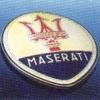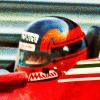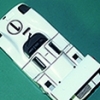Was the move away from a more true gold effect to a (slightly brighter?) painted colour something to do with how well the livery appeared on film or tv?
I wouldn’t doubt it Tony, if the decision went beyond mere budget, practicality (such as, what if a panel needs matching on a race weekend?), and durability.
“Brighter” depends entirely on light when it comes to gold paint and gold leaf. In bright sunlight, real leaf radiates so gleamingly as to almost be painful to look at, but in dim light it fails terribly. A traditional lettering enamel mixed to a contrasty shade would definitely be more legible under varied lighting conditions, not to mention being very durable when applied correctly.
Another, much-cheaper technique uses “gold size” — a very slow-drying varnish of sorts that’s applied with a little blended color so you can see what the brush is doing — with a gold-looking (probably brass) powder dry-brushed over the (very!) slightly-tacky size. If done right, it looks like it was lettered in metallic gold paint (which is terrible to work with in brush mediums), but without varnishing does not hold up well to even repeated waxing.
The side number panels on the 72s always struck me as having been spray painted over a mask, but I’m on the fence about the balance of the cars.
The more I think about it, the less I think the cars ever used actual gold leaf... the gold material on “patent leaf” is about 1/250,000 of an inch thick, and even when applied onto slow size it’s remarkably durable it’s a very tedious process and slow-going in the best of cases.
Sorry for the diversion(s).
Edit: Saw your reply, Gary. Interesting comment from Peter, neat to confirm that. I will add, though, that the 72s would have taken *a lot* more than four books, each book covering less than two square feet of perimeter over each graphic. But in the day the materials were a lot cheaper than labor so not a deciding factor.
Edited by E1pix, 08 March 2023 - 08:26.



















